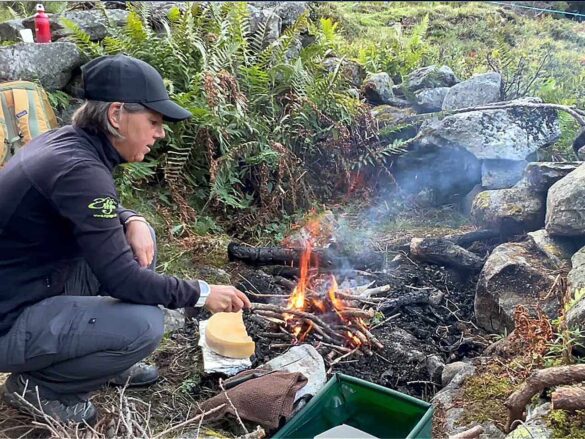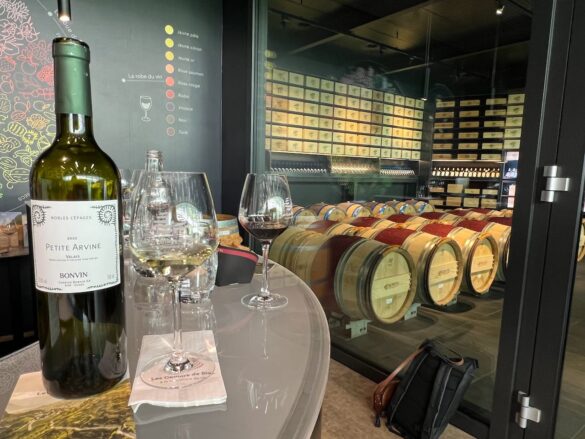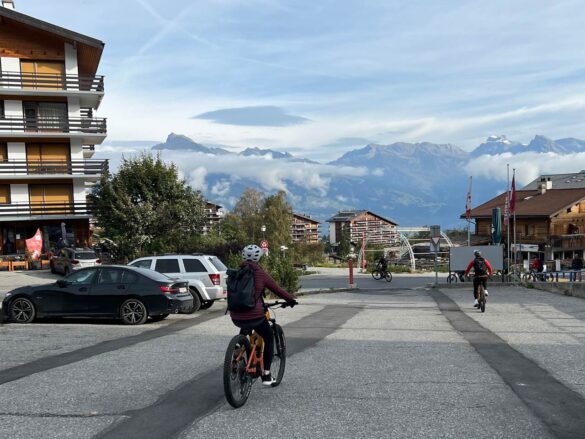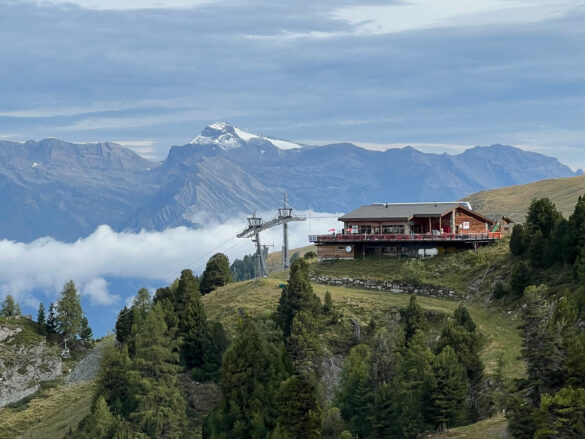Valais is in southwestern Switzerland, is well-suited to gentle spring, summer and autumn hiking. And easy to get to. I travelled from Geneva airport and used the extremely efficient rail and bus network and a Swiss Travel Pass to arrive and get around.
Cheese and wine
It’s the country’s largest wine region and the vineyards cover the southeast-facing slopes of the dramatic Rhône river valley. It’s also an area where cheese is loved. Switzerland’s canton of Valais is the home of Raclette, a meal first mentioned in medieval Swiss texts in 1291 and loved by cow herders for centuries.
The authentic way to experience this delectable dish is to huddle around a small campfire in the mountains and gradually melt the local unpasteurized, full-fat cow’s milk cheese onto slabs of bread. And that’s exactly what we did.
“Raclette cheese can also be served with potatoes and pickles,” explained Elodie from Nendaz Tourism, who had organised our culinary excursion. But nothing beats this simplest of suppers, washed down with a flask of hot tea or wine, on the side of an Alpine ridge.
Fendant is one of the main varieties of grape and Valais legend has it that Louis XV of France’s gardener travelled from Versailles to demonstrate how to grow it. (Though some patriotic afficionados insist the knowledge came from Geneva.) The fruity, dry wine is an alternative accompaniment for addictive Raclette. (Once you’ve tried it once, you have to have more.)
Bisses of Valais
The traditional and carefully restored bisses of Valais run along accessible walking trails, well signposted and perfect for varying abilities. These wooden irrigation channels were erected long ago to bring precious glacier water to the cultivated land.
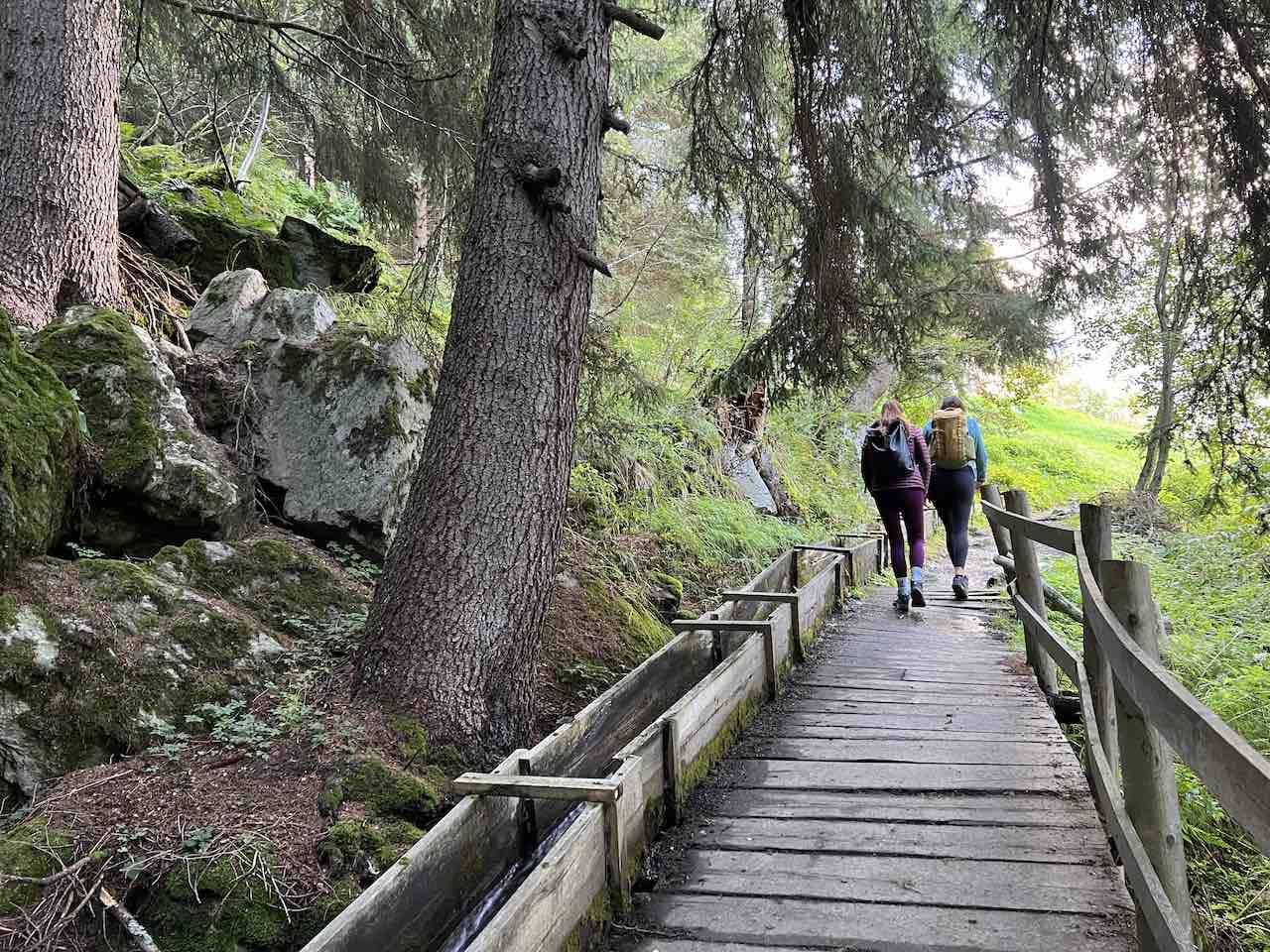
Nendaz path ©BWatts
I used www.valais.ch’s map to ramble between Nendaz and Veysonnaz, an easy route that follows the Bisse Vieux and 15th century Grand Bisse de Vex. It took me around four hours in total, plus a stop for lunch in the hamlet of Planchouet. (A yellow sign indicates an undemanding path, a red and white sign means more challenging steeper terrain.)
Both canals are fed by the river Printse and the Bisse Vieux – bordered by quirky sculptures – waters apricot trees, raspberry bushes and meadows of oregano and wild thyme. I passed houses with stone-slab roofs, set in larch and conifer woodland, and rare black squirrels skittered up trees at the sound of my footsteps. Their black colour is an unusual gene variation dominant in these parts.
The black squirrels may be timid but the native black cattle, the Hérens, is not. Short and stocky, with a dark coat, this breed has strict social hierarchies and fight to decide which cow leads the others to and from Alpine pastures.
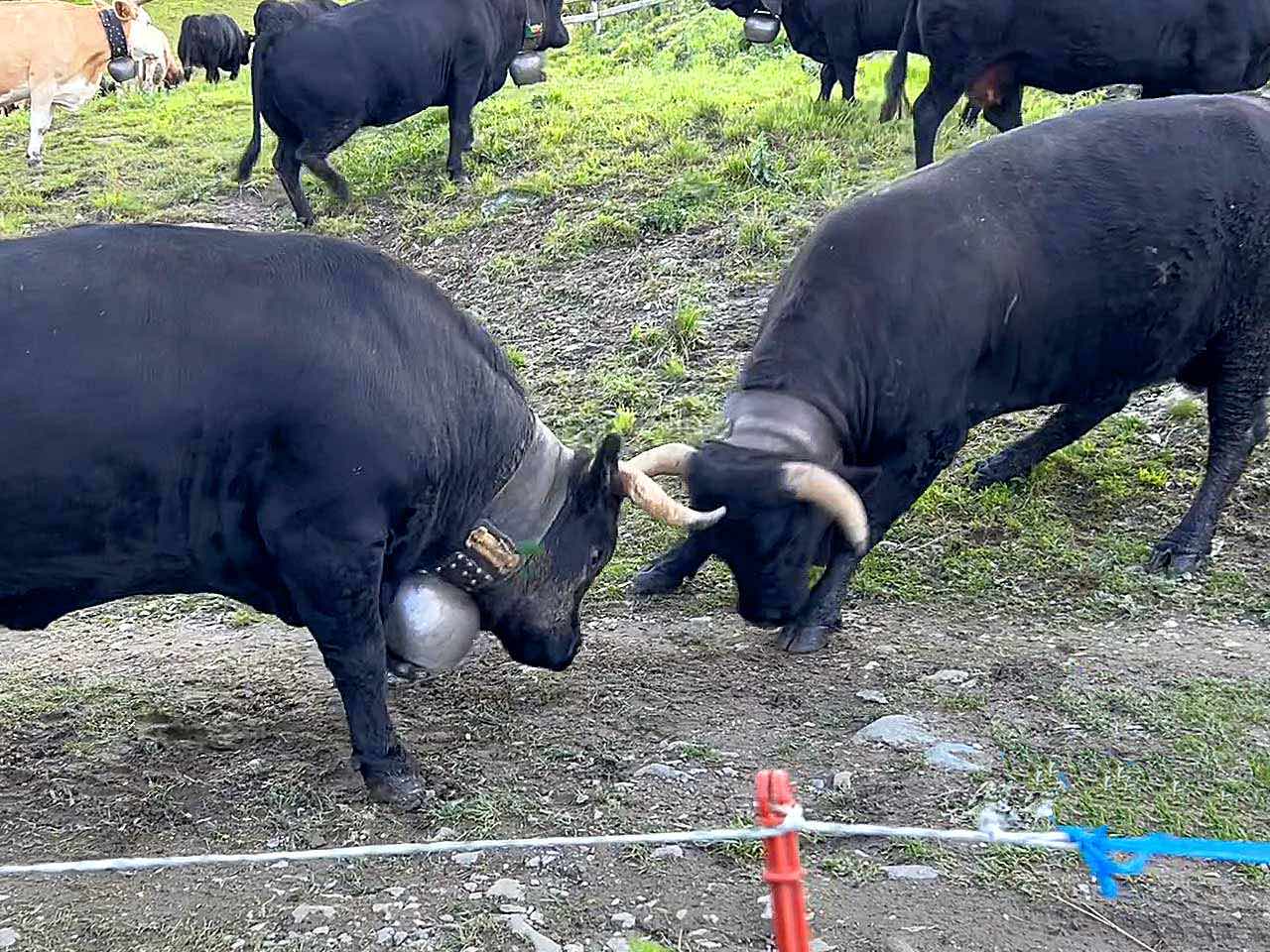
Cow clash ©BWatts
It’s hard to believe they’re so keen to pick a fight but we watch a seemingly nonchalant herd trampsing back to the dairy and a minor fracas breaks out, with a bit of a stand-off and clashing of horns. (They were only interested in each other, not us.)
Yoga in Magrappé forest
Valais is blessed with a remarkably dry and sunny climate and enjoys 300 days of sunshine a year. There’s a designated Yoga Path in the Magrappé forest for those who like to practice yoga outdoors and cycling and e-biking are also huge here. In September 2025, Valais will become the mountain bike capital of the world with the UCI Mountain Bike World Championships taking place.
I fall off bikes so stuck to hiking. The Bisse de Chervé is the highest of the Valais bisses and the entire length runs above 2,200 metres. Taking the Combatseline chairlift, I followed the trail towards Cleuson dam lake, the water a vivid ‘bleu de Cleuson’ because of the refraction of light.
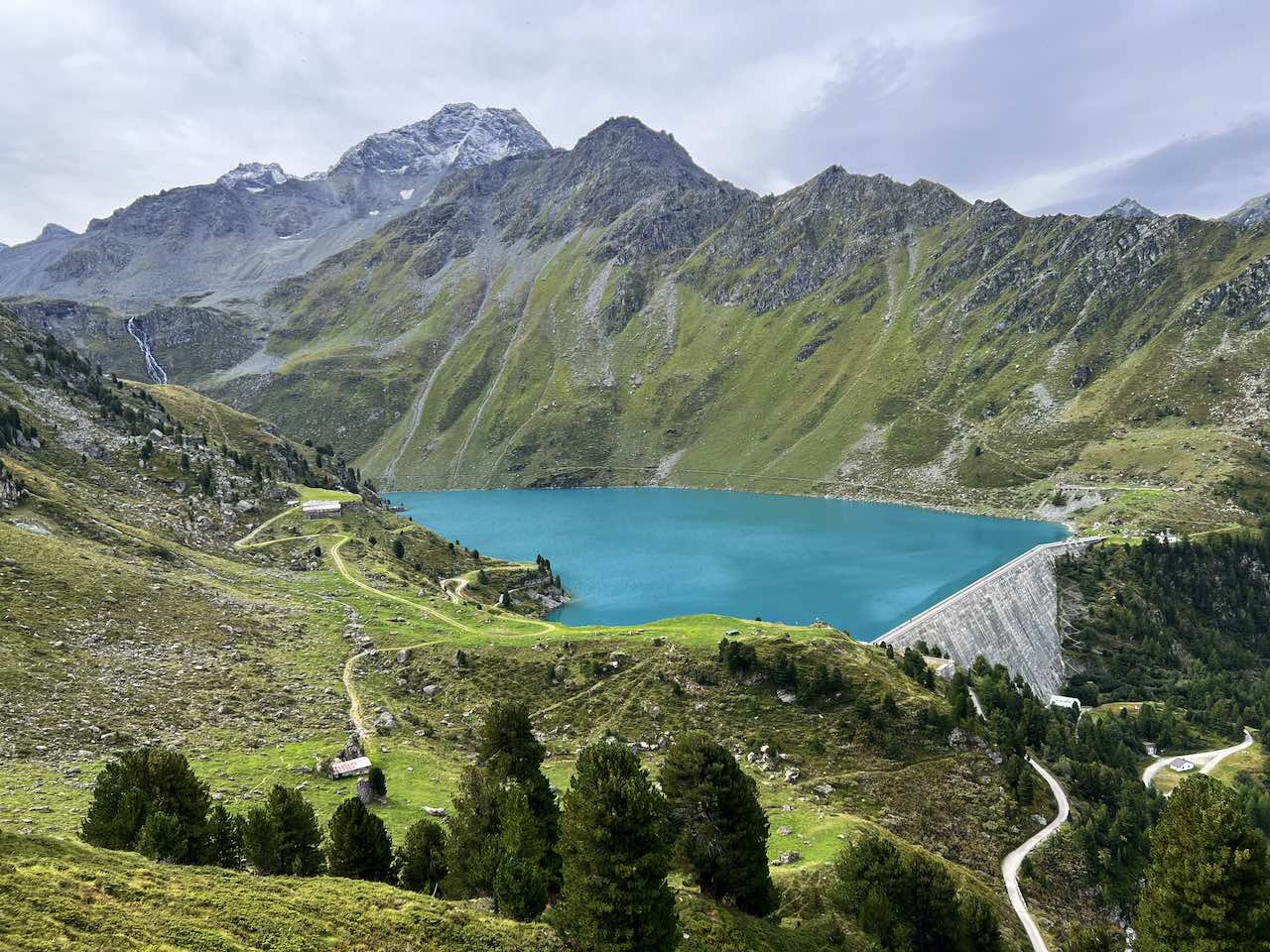
Cleuson dam lake ©BWatts
On its banks you’ll find St-Barthélémy Chapel with a panoramic view to the Bernese Alps. Dating back to 1447 and originally a timber structure, it was moved from the small valley of Cleuson and rebuilt in stone in 1951 by the barricade’s construction workers.
The path down starts to zigzag away at the foot of the dam where marmots have been spotted and agile Chamois goat-antelopes scale the steep wall to lick salt from the surface.
The witches of Sion
I’d read about the town of Sion and was curious about seeing the creepy 13th century Sorcerers’ Tower — once part of the city walls and also a prison — because it’s associated with the witchcraft tribunals of the Inquisition.

Over town of Sion ©BWatts
The Valais trials between 1428 and 1447 led to hundreds of victims being executed for sorcery. The accused were charged with being in cahoots with the devil, who appeared as a black bear (or possibly, I pondered, a black cow or squirrel!).
The tower is just a half hour walk away from The Oenoparc at Les Celliers de Sion, a wine and vine centre that offers indoor and outdoor events and tastings throughout the year.
Less than 5% of Switzerland’s wine is exported so the Swiss keep most of their excellent production. I learnt about the fragrant Petite Arvine, with its unique DNA, a quintessential Valaisan white wine grape with a slightly mango or grapefruit bouquet.
It’s wonderful paired with cheese and Valais also has good goat’s and sheep’s cheese, which we have to try. Tomme is made from skimmed milk (cow, goat or ewe’s), Serac from whey, and fondue is a blend of Gruyère and Raclette.
Did I mention the Swiss love cheese?
Fact File
FLY: Swiss International Air Lines (SWISS) flies from UK airports to Zurich and Geneva, from £54 one-way.
Moving around The Swiss Travel Pass, from £186 for a three-day second-class ticket, includes the Swiss Museum Pass and unlimited travel on consecutive days using the Swiss Travel System’s rail, bus and boat network. It’s two hours on the train from Geneva Airport to Sion and half an hour by bus from Sion to Veysonnaz.
STAY: Stay and eat Hotel Chalet Royal in Veysonnaz and Hotel Mad Mount in Haute-Nendaz both have spa facilities.
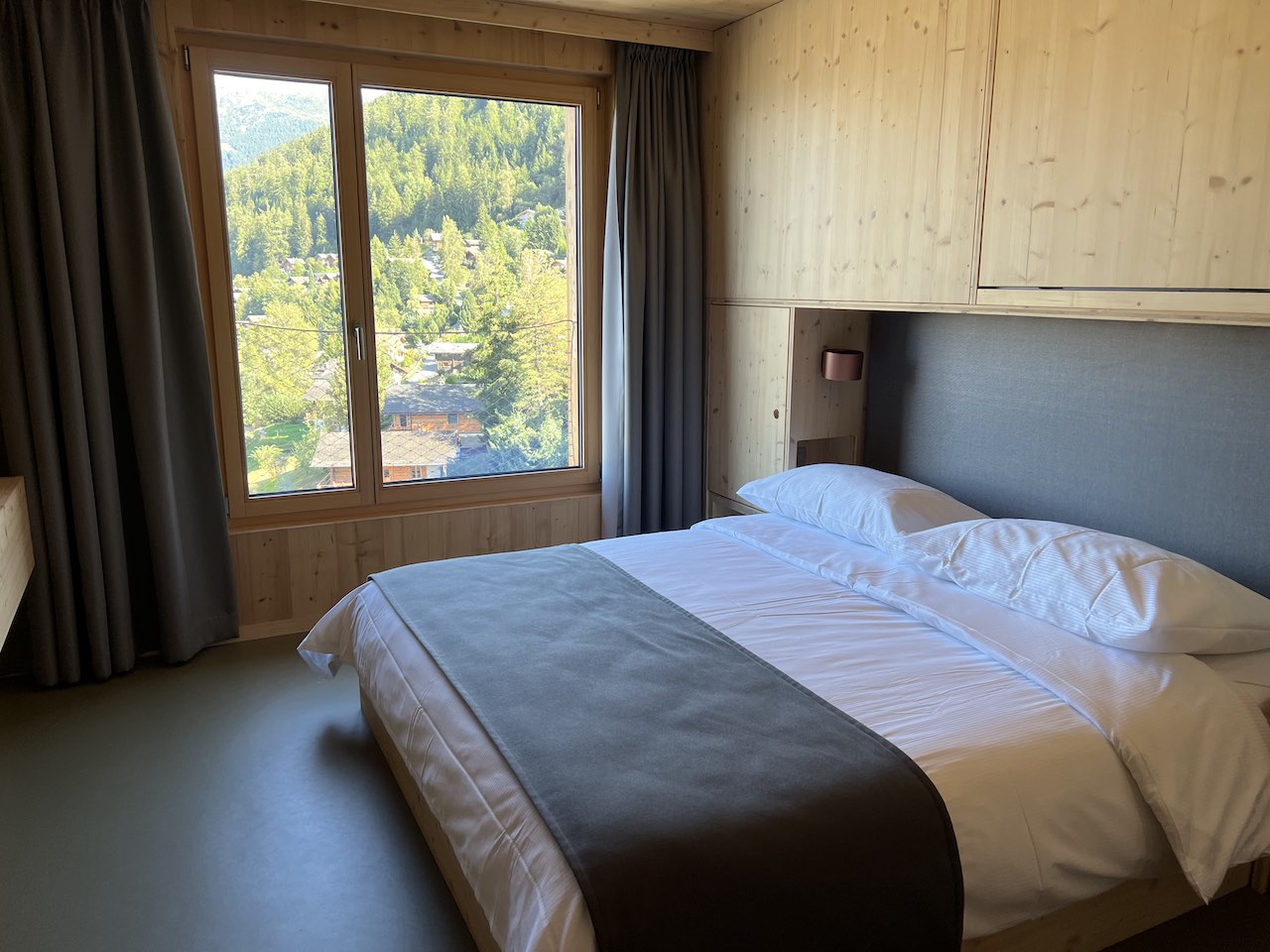
Hotel Mad Mount view ©BWatts
Share a Valais fondue for two at Le Magrappé restaurant (Veysonnaz), lunch on the terrace of the Restaurant de Planchouet on your hike and try the meat dishes cooked on slates at Le Grenier, Nendaz.
You may also like: Cervo Mountai Resort retreat in Switzerland
The post Valais Travel Guide: Wine, witches and walking in Switzerland appeared first on The Travel Magazine.















